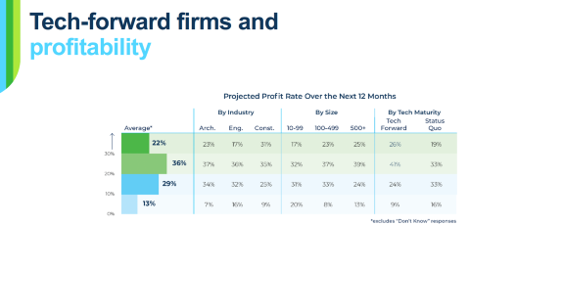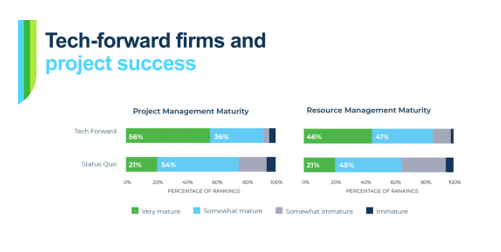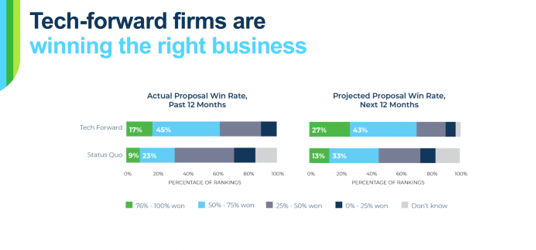The Rise of the Tech-Forward AEC Firm, Part 1
Unanet’s latest AEC industry benchmarking report shows how embracing technology is paying off for AEC firms

Could an architecture, engineering and construction (AEC) firm’s progressive use of technology actually drive better overall firm performance? The answer, based on findings from Unanet’s latest benchmarking report for the AEC industry, appears to be a resounding “Yes!”
Results from the AEC Inspire Report 2022-2023 (download a free copy here), based on a survey of close to 400 AEC firms, establish a direct link between a firm’s embrace of technology, its overall performance and its outlook for the future. The data clearly shows that tech-forward firms surpass their less tech-focused (the report refers to them as “status quo”) peers in several key areas.
What makes an AEC firm tech-forward, exactly? For the purposes of our benchmarking survey, companies had to meet at least three of the following four criteria:
-
They consider themselves “very data driven.”
-
Their tech systems and applications are fully or mostly integrated.
-
They’re cloud-enabled, with at least half of their software and business apps based in the cloud.
-
Most or all of their tech tools are mobile-enabled.
Based on these criteria, slightly less than one-third (32%) of the AEC organizations we surveyed for the AEC Inspire report qualify as tech-forward. Let’s look more closely at what firms in the tech-forward minority do differently than firms in the tech-static majority.
- They have a mastery of their data. Inside a tech-forward firm, data and the insight it yields flow unimpeded and multi-directionally. This enables a firm to schedule and allocate resources more efficiently, manage projects more effectively, more closely track project and firm-wide KPIs, more closely monitor and manage client and employee experience, and strategically plan more effectively over various time horizons.
- They’re big on integration. Their digital systems connect seamlessly, their organizational “nervous system” runs on integrated apps, and their workforce is empowered by automation, information and streamlined processes.
- They’re cloud-focused. Housing key business applications, processes and information in the cloud gives firms scalability, efficiency, security and cost advantages over firms that rely on on-premise tech and systems.
- They’re mobile-enabled. Their people have ready remote and mobile access to the same digital tools, systems and data they have access to in the office.
Having identified what makes tech-forward firms different, we dug deeper into the data to identify several key areas where these tech-forward qualities translate directly into better performance:
At the project and firm bottom lines
- 67% of tech-forward firms project a profit rate of at least 20% in the next 12 months, compared to 52% of tech-static firms.
- 14% of tech-forward firms report a direct labor multiplier of at least 3.5 over the past 12 months, compared to 4% of tech-static firms.

In executing projects
- About half of tech-forward firms consider their project-management and resource-management processes very mature, compared to one-fifth of tech-static firms.
- Half of tech-forward firms reported that recruiting and maintaining appropriate staffing
levels have improved since the pandemic, while among tech-static firms, almost half (46%)
indicated they have done worse in this area since the pandemic.

In capturing their market
- 17% of tech-forward firms report a project win rate in the 75-100% range over the last 12 months, compared to 9% of tech-static firms.
- 27% of tech-forward firms expect their win rate will be in the 75-100% range for the next 12 months, compared to 13% of tech-static firms.
- 34% of tech-forward firms report a capture rate higher than 50%, compared to 21% of tech-static firms. Capture rate is the total dollar value of the projects a firm wins as a percentage of the total value of the projects on which a firm bids. It’s a powerful metric for its ability to gauge the extent to which a firm is winning not just any business, but the right business.

As competitive as today’s AEC business is, firms must be better than their peers at landing new business, attracting and retaining talent, and delivering superior project outcomes. As roughly one in three AEC firms have discovered, an embrace of digital technology can provide that edge. Stay tuned, because in our next post, we’ll continue digging into the AEC Inspire report to reveal the steps firms like yours can take to leverage technology and data to reap the benefits of being tech-forward.